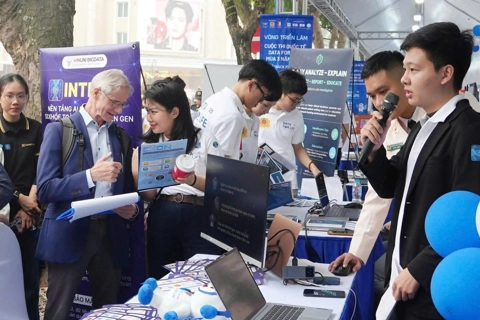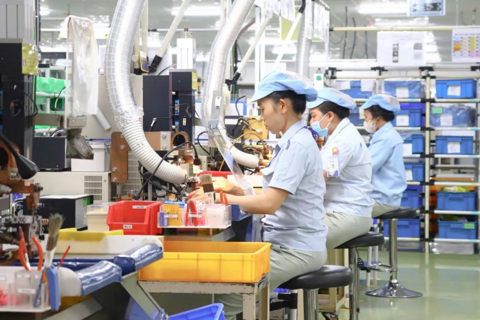Vietnam's universities expand semiconductor programs
Vietnam is estimated to face a shortage of 20,000 qualified personnel in the semiconductor industry in the next five years as foreign-invested enterprises pour money into the country's sector.
More universities and colleges in Vietnam have launched their enrolment plans for semiconductor training in the 2023-2024 academic year.
| Lecturer and students of Hanoi Industrial Vocational College (HNIVC). Photo: Tran Oanh/The Hanoi Times |
Semiconductor technology and integrated circuit design are expected to be the most talked-about industries in the 2024 enrolment season due to rising demand for labor and competitive wages.
Semiconductors are the foundation of today's technology, driving innovation in a wide range of fields.
The growing demand for advanced microchips has placed the global semiconductor market at the forefront of technological advancement. In this context, Vietnam is a prominent player rapidly rising in the world semiconductor rankings.
To seize the opportunities and meet the demand, a number of tertiary institutions have announced plans to admit more candidates for semiconductors while many others launched enrollment plans for the first time.
So far this year, more than 10 universities have made public their enrolment plans for newly opened majors of integrated circuit design and semiconductor technology in the enrollment season 2024 and 2025 for both graduate and master programs.
They are the leading ones in Vietnam’s tertiary education like Hanoi University of Science and Technology (HUST); Saigon International University (SIU); Can Tho University, FPT University; Phenikaa University; the University of Danang (UD) (including University of Science and Technology, University of Technology and Education, Vietnam – Korea University of Information and Communication Technology).
Other institutions that have announced enrolment in semiconductors include Vietnam National University Hanoi (VNU) – University of Engineering and Technology (UET); Vietnam National University Ho Chi Minh City (VNUHCMC) – Ho Chi Minh City University of Technology (HCMUT); University of Science and Technology of Hanoi (USTH).
| Vietnam's semiconductors industry in 2018-2028. Source: Technavio |
Demand and training
Statistics by market research company Technavio showed that Vietnam’s semiconductors market is projected to reach $7 billion by 2028, with a compound annual growth rate (CAGR) of 6.69% in the 2023-2028 period. Analysts believe that growing investments in 5G technology is an emerging trend that will shape market growth. Vietnam intends to expand the reach of the 5G network in urban areas and high-tech industrial zones to license the 5G commercialization across the country soon.
The Vietnamese government is encouraging investment and development of the semiconductor industry as it sees microchips as a critical area and wants to position Vietnam as a key player in the global semiconductor supply chain.
The Prime Minister has tasked the ministries of Planning and Investment, Information and Communications, and other ministries and agencies with building action plans and strategies for this industry, particularly regarding human resource development.
According to the Ministry of Education and Training (MOET), there have been 50 foreign-invested enterprises in the semiconductor industry in Vietnam, with the strongest demand coming from IC design. Local experts said the country would be in demand for about 5,000 personnel in IC design and it needs about 3,000 people for training each year a third of whom should have master’s degrees.
After the US and Vietnam upgraded the relationship to a comprehensive strategic partnership in September 2023, the demand for manpower would be on the rise following investments by American semiconductor giants, economists at Fulbright University predicted. In the next five years, Vietnam needs approximately 20,000 people trained in this industry and up to 50,000 in the next 10 years.
In fact, semiconductor technology is not a completely new field of study. As of September 2023, the country had 35 higher education institutions qualified for semiconductor-related training.
For this year's enrolment, universities offer four types of admission, including a competency assessment test, high school result verification combined with interviews, direct admission, and high school graduation exam results.
Prof. Chu Duc Trinh, Rector of VNU – UET, said that since the 1990s and early 2000s, Vietnam has sought solutions to develop the electronics industry. Two decades later, the country is still asking the question, but it's in a different position: how to make it an essential industry in the economy.
In 2022, Vietnam’s electronics exports hit US$114.4 billion, accounting for more than 30% of the country’s total export turnover. The value ranks Vietnam as the 3rd largest ASEAN exporter and the world’s 12th.
“The electronics industry has grown recently, but we haven’t taken advantage of it. Developing domestic industries is still an ongoing process requiring internal resources, technology, and, above all else, people to achieve sustainable industrial development and establish ourselves as a significant global player,” Chu Duc Trinh said.
He said it’s better to boost cooperation between schools and businesses to maximize the effective training and research that benefits students and lecturers. Training in this field could become globally standardized and meet the factual demand of the global supply chain if the partnership is successful and there are enough well-invested facilities and curricula.
Sharing with The Hanoi Times, Phan Van Vuong, Vice Dean of Electricity - Electronics Faculty at Hanoi Industrial Vocational College (HNIVC), stressed the importance of collaboration between training facilities and businesses as the model saves training costs while ensuring quality. It also helps lecturers enrich their knowledge and gain experiences to provide better courses.
A survey conducted by the Ho Chi Minh City Semiconductor Circuit Technology Association (HSIA) showed that a graduate IC design engineer earns an average of VND15 million ($612) per month and $1,222/month after three years, about $40,000/year after six years, and more than $61,212/year with more than 10 years of experience.
Associate Prof. Nguyen Duc Minh, Dean of Electronics Faculty, Hanoi University of Science and Technology (HUST), all IC design engineers have jobs after graduation with an initial offer of VND15 million ($612)– VND20 million ($820)/month, the same as in information technology (IT). After a few years, the salary would be VND60 million ($2,448) – VND70 million ($2,856)/month, 70% higher than in IT.









